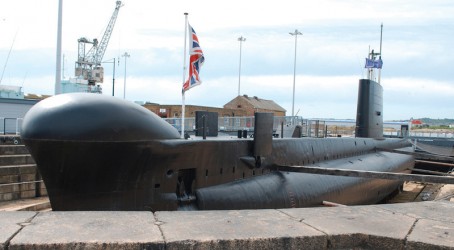Established in the 16th century, the Chatham Dockyard on the Medway was at the forefront of shipbuilding for more than 400 years. At its height, it employed 10,000 skilled workers, provided more than 500 ships for the Royal Navy and covered a sprawling 400-acre (162ha) site.
During the reign of Queen Elizabeth I, the yard was England’s principal fleet base. As the river began to silt up in the early 17th century, the dockyard moved downstream, to its present location. The site is now home to a large collection of historic ships, museum galleries and iconic buildings, the oldest of which is the Commissioner’s House, built in the early 18th century.
The large yard takes some time to navigate, so it’s best to plan your route in advance.
The No. 1 Smithery houses an art gallery, and showcases previously unseen artefacts from the collections of the National Maritime Museum and the Imperial War Museum. Many fine models are displayed here, including one of the Eddystone Lighthouse, designed by civil engineer John Smeaton.
Nearby there’s an interactive floor, which shows how the metal pipes used in shipbuilding were heated and bent into shape.
The Victorian ropery is particularly popular with younger visitors. Here visitors are transported back to 1875 to learn about why rope was so important to the Navy, and learn how to make their own rope. The quarter-mile-long ropewalk, where Chatham rope is still made to this day, is impressive.
The 3 Slip – The Big Space is a variety of large exhibits from the collections of the dockyard and the Royal Engineers Museum. There’s a midget submarine, giant tools, steam machinery, mine-clearance equipment and even a Chieftain AVRE tank.
By the mid-18th century, the shipyard was the largest industrial organisation in the world, responsible for building ships including HMS Victory, Lord Nelson’s flagship at the Battle
of Trafalgar.
Today the most popular thing to do at the yard is to tour the three warships berthed on site.
The WWII destroyer HMS Cavalier serves as a memorial to the men lost at sea during that war, while HMS Gannet, a Victorian sloop, shows what life onboard was like in the 19th century.
But it is a tour of the third vessel – a Cold War submarine – that really steals the show. HMS Ocelot was one of 57 submarines built at Chatham between 1908 and 1960, and the last to be built by the Royal Navy at the yard. Its cramped passageways and hatches are fun, if a little unnerving, to navigate. They give a feel of what it was like to work and live onboard.
The underwater vessel story is continued in the Steam, Steel and Submarines exhibition, with displays on the yard during the 19th and 20th centuries, and on the workers who were key to its success.
Also worthy of a visit is the RNLI historic lifeboat collection where 17 vessels, all different in age and size, can be seen up close.

5 things to see
HMS Ocelot: Squeeze into the Oberon-class diesel electric submarine, which served throughout the Cold War.
Get roped in: Join a costumed tour and learn how to make your own rope.
Maritime treasures: Visit the Smithery to find out how the models of ships and buildings were made, and about the craftsmen who built them.
RNLI lifeboat collection: The preserved vessels on display have participated in many memorable rescues.
Pipebending floor: Find out how pipes were heated and bent around pegs in the floor to make them the right shape.